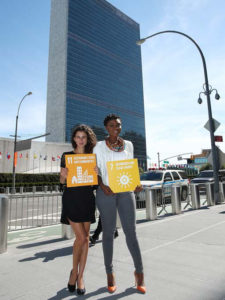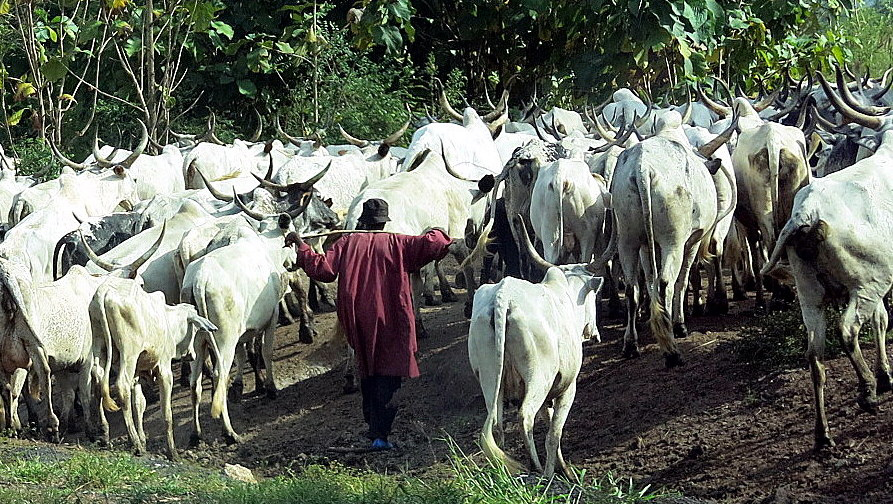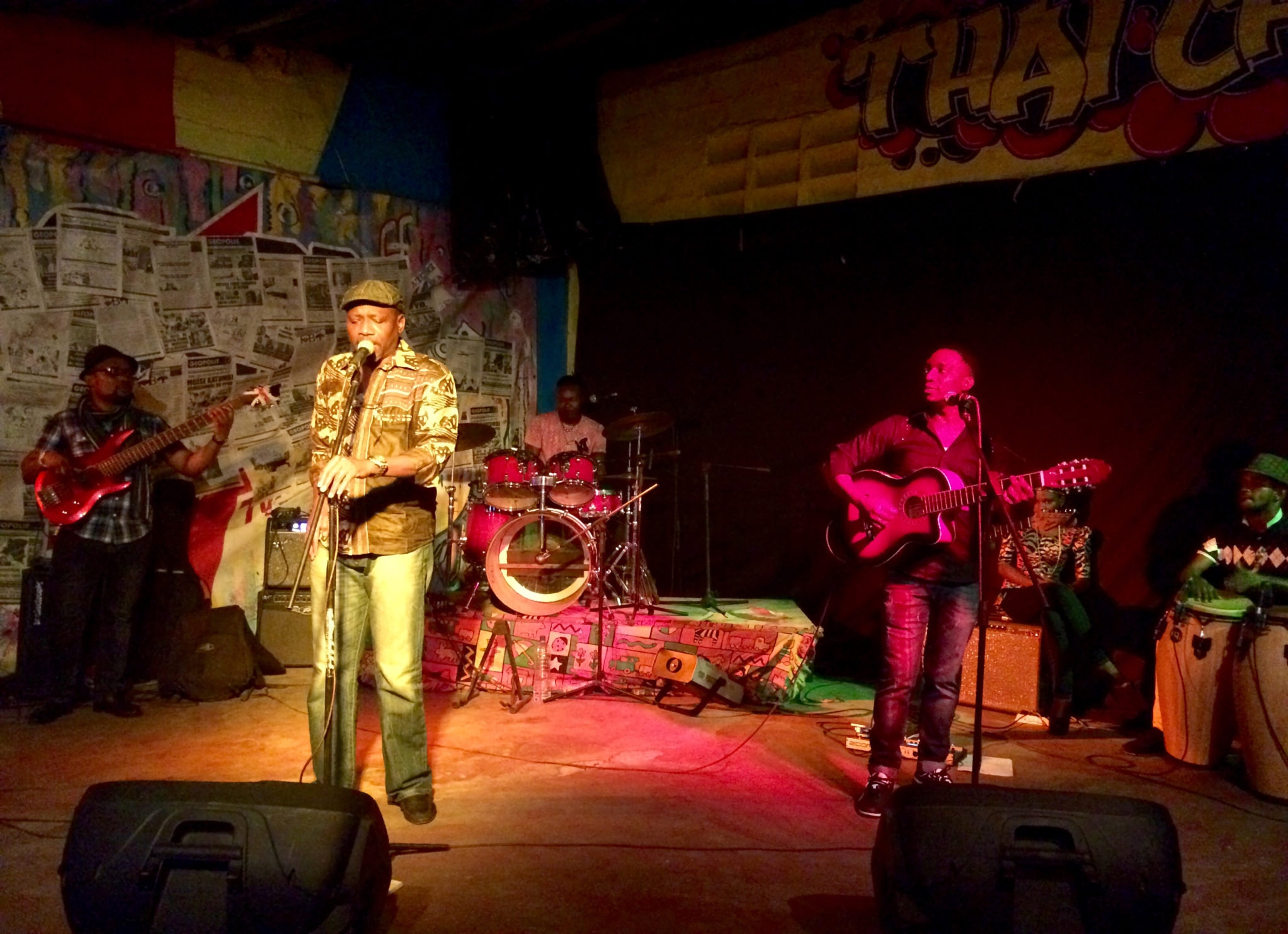SDGs: overview
Although African countries lag behind in implementing SDGs, the 17 goals are being institutionalised around the continent

Brazilian activist Alessandra Orofino and Ghanaian Singer/actress Becca pose for a photo in front of the United Nations following the premiere
of Project Everyone’s Global Goals cinema
advertisement at the United Nations, New York.
Photo: Jemal Countess / AFP
By Osita Agbu
Today, the world is faced with developmental problems, many of which are global in nature and require concerted action to address. These problems can be expressed as goals and targets that need to be resolved in the interest of peace and security, attainment of human security and the survival of humankind. These goals could be political, social, economic or cultural. Examples include the desire of the international community to reduce poverty globally, mitigate climate change and promote universal primary education (UPE).
The Sustainable Development Goals (SDGs) represent the most concerted attempt to address cross-cutting issues such as these. To appreciate the ramifications of the SDGs, it is necessary that we briefly revisit the Millennium Development Goals (MDGs), which the international community identified and declared as important international development goals in 2000. Following the Millennium Summit UN in 2000, some 191 UN member states and at least 22 international organisations committed themselves to helping to achieve the MDGs by 2015.
The MDGs included eight goals with measurable targets and clear deadlines aimed at improving the lives of the world’s poorest people. The eight goals aimed to: eradicate extreme poverty and hunger; achieve universal primary education; promote gender equality and empower women; reduce child mortality; improve maternal health; combat HIV/AIDs, malaria and other diseases; ensure environmental sustainability and develop global partnerships for development. But critics of the MDGs complained of a lack of proper analysis and justification behind the chosen objectives, pointing to a lack of measurements for some goals or difficulties in measuring them, as well as uneven progress in their implementation.
Developing countries, mainly in Africa, saw more than 50% of development assistance going to debt relief, disaster relief and military aid, rather than substantive development. Even before they were terminated in 2015, governments and organisations set out to improve upon the performance of the MDGs. Hence, in 2012, the UN secretary general established a task force that brought together more than 60 UN agencies and international organisations to work on sustainable development in line with a “post-2015 UN Development Agenda”.
The SDGs are a set of 17 “global goals” with 169 targets. These goals and targets cover a broad range of sustainable development issues that include ending poverty and hunger, improving health and education, making cities more sustainable, combating climate change and protecting the oceans and forests. Outlined in paragraph 54 of the UN Resolution A/RES/70/1 of September 2015, the SDGs are officially known as Transforming Our World: The 2030 Agenda for Sustainable Development. The UN-led process aimed at formulating them involved 193 member states and global civil society. These goals constitute the post-2015 and 2030 development agenda.
“The SDGs are all about development of every individual in the world,” says Dr Ronald Kayanja, director of the United Nations Information Centre in Lagos, Nigeria. Governments all over the world are expected or encouraged to do the following: translate the 17 Goals, 169 targets and 304 indicators as applicable into national legislation, develop a plan of action, allocate a budget for its implementation and be open and search for partners. Given that such tasks require considerable resources, poor countries are likely to need the assistance of richer nations, while coordination is crucial at international level. It is estimated that achieving the SDGs will cost between $2 and $3 trillion over the 15-year period between 2015 and 2030.
The 17 Sustainable Development Goals are: end poverty in all its forms everywhere (SDG 1); end hunger (SDG 2); ensure health and well-being (SDG 3); quality education (SDG 4); gender equality (SDG 5); clean water and sanitation (SDG 6); affordable and clean energy (SDG 7); decent work and economic growth (SDG 8); industry, innovation and infrastructure (SDG 9); reduced inequalities (SDG 10); sustainable cities and communities (SDG11); responsible consumption and production (SDG 12); climate action (SDG 13); life below water (SDG 14); life on land (SDG 15); peace, justice and strong institutions (SDG 16) and partnerships for goals (SDG 17).
While all the goals are important, African countries appear to be paying more attention to SDG 1 (ending poverty), SDG 2 (ending hunger), SDG 5 (gender equality), SDG 13 (climate action) and matters relating to SDG 16 (peace, justice and strong institutions). This is evident from a content analysis of the SDG Index and Dashboards report presented by the Sustainable Development Goals Center and Sustainable Solutions Network for 2018. Although extreme poverty has been cut in half since 1990, more than one in five people still live on less than $1.25 per day. As we know, poverty is more than the lack of income and resources. People live in poverty if they lack basic services such as health care and education, while also experiencing hunger, social discrimination and exclusion from decision-making processes.
Gender inequality plays a significant role in perpetuating poverty and its risks. Women face potentially life-threatening risks from early pregnancy and frequent pregnancies. This could undermine the quest for education and a better income. Poverty also affects age groups differently, with children most seriously affected, because poverty undermines their education, health, nutrition and security, and negatively affects their emotional and spiritual development. On climate action, it is clear that climate change and its impact on our environment need to be addressed by regulating emissions and promoting developments in renewable energy. The UN seeks to address this issue through so-called financing for development and by hosting conferences that bring major parties together.
We should note that development and climate are linked, particularly as regards poverty, gender equality and energy. The main UN body responsible for climate issues is the UN Framework Convention on Climate Change (UNFCCC), which aims to encourage the public sector to take the initiative in minimising (or mitigating) the negative impact human activities have on the environment. On the whole, there has been some convergence of the MDGs and SDGs, especially as regards eradicating poverty, promoting gender equality and fostering environmental sustainability. Coincidentally, these are critical goals for many African countries. Looking at Africa’s Agenda 2063 and the SDGs, we see that it is possible to align measures of continental integration to the metrics in SDG Goal 17, making it possible to compare regional and country performance on SDGS.
Indeed, an AU-UN Framework for the Implementation of Agenda 2063 and the 2030 Agenda for Sustainable Development was signed in January 2018. This agreement aims to ensure that both institutions undertake joint activities and programmes for the effective implementation, tracking and reporting of both the 2030 Agenda and the 2063 Agenda, according to the 2018 Sustainable Development Goals Center report. It would appear that African countries are lagging behind in implementating SDGs, but we also observe that SDG goals are being quite strongly institutionalised around the continent. The executive branches of several African countries have embedded the SDGs in their national development strategies. In a 2018 survey of 11 African countries carried out by the SDG Center and the Sustainable Development Solutions Network, it was found that 90% of these had already aligned their national strategies with the SDGs, and 70% had an action plan to implement the SDGs.
These countries included Morocco in North Africa; Benin, Ghana and Senegal in western Africa; Kenya and Rwanda in eastern Africa; Cameroon and Gabon in central Africa; and Namibia, South Africa and Zambia in southern Africa. North African countries such as Morocco and Tunisia ranked highest on the implementation average index score. Relative to sub-Saharan Africa for instance, the North African countries performed better on poverty (SDG 1) and energy access (SDG 7). However, gender equality (SDG 5) is still a problem in this region. In respect of trends, it appeared that North Africa was on track to achieve the SDG goal on poverty, with the exception of Libya, which was regressing. In East Africa, infrastructure development is the main challenge facing the region, followed by health (SDG 3), and peace and justice (SDG 16).
The best performing goal for this region is climate action (SDG 13), followed by inequality (SDG 10). This region also appears to be making progress on gender equality (SDG 5) and economic growth (SDG 8). In Rwanda, for example, a governmental steering committee and a national partnership group leads implementation of SDGs. Their work has been much enhanced by aligning their interventions with Imihigo, or performance contracts, while targets and indicators were derived from various national plans, including the Economic Development and Poverty Reduction Strategy (EDPRS). So far, they have evaluated 160 of the 232 SDG indicators, of which only 89 were found to be relevant to the Rwandan context.
In southern Africa, the main challenge is health (SDG 3), followed by poverty (SDG 1) and infrastructure (SDG 9). Progress has been made on quality education (SDG 4), sustainable cities (SDG 11) and climate action (SDG 13). Mauritius is the best-performing country overall. It is important to note that this region surpasses all other regions on partnerships for the goals (SDG 17), mainly because of impressive performances by Mauritius and Mozambique. However, South Africa is also doing well on gender equality and infrastructure development. West Africa generally returns an average performance, with some countries performing fairly and others, includingNigeria, not doing well. Ghana is a high performer because it has embedded the implementation and monitoring of MDGs in its presidential office, which provided a good base for the same approach to SDGs.
The country’s SDGs coordinating structure is spearheaded by three institutions: the SDG Implementation Coordination Committee (ICC), the High-Level Inter- Ministerial Committee and the National Technical Steering Committee. The Ghana Statistical Service has identified 62 SDG indicators that it already produces, another 63 indicators that it could produce with improvements to existing data, and a further 30 indicators for which it has no data, according to the SDG Center. Nigeria showed some progress in improving quality education (SDG 4), with a net primary enrolment rate of about 64.1%. However, its performance on ending poverty (SDG 1), climate action (SDG 13) and gender equality (SDG 5) are unimpressive. For example, the number of women aged 20 – 24 that are married or in a union before the age of 18 is still significant and has implications for gender equality.
The percentage of seats women hold in the national government of the 4th Republic is still about 5.6%. For barrister Ebere Ifendu, chairperson of Women in Politics Forum (WIP), this means that women are poorly represented in national government.“This is because there is no internal democracy in political parties, with the result that women are unable to come out as candidates,” she told Africa in Fact. In 2015 for instance, only 12 out of 360 members of the House of Representatives were women. In fact, it was against a backdrop of failure to attain the MDGs in 2015 that the government and other stakeholders decided to take the implementation of the SDGs more seriously. Hence, Nigeria established the office of the senior special assistant to the president on SDGs, which is a carry-over from the approach to MDGs under the presidency. In addition, there is the House and Senate committee on SDGs, as well as an inter-ministerial committee on SDGs, established to coordinate engagement with ministries, departments and agencies.
Furthermore, there is also a private sector advisory group, and a civil society strategy group, on SDGS. With all this array of institutions, and with the appropriate funding, Nigeria is expected to improve its performance in the near future. Central Africa as a region appears to have the lowest average performance with regard to performance on SDGs. Health (SDG 3) and peace and justice (SDG 16) are the main challenges facing the region, followed by energy (SDG 7) and infrastructure (SDG 9). The region has performed poorly in partnership and regional integration (SDG 17). It has, however, made progress in climate action (SDG 13), life on land (SDG 15) and inequalities (SDG 10). Gabon and Cameroon are its best performers, according to the SDG Center. Nigeria’s case demonstrates that the road to achieving SDGs in Africa will not be smooth. The Boko Haram insurgency is ravaging the northeast, while intercommunal clashes between herders and farmers are destabilising the central region.
The manufacturing contribution to Nigeria’s gross domestic product (GDP) has been below 10% for more than three decades, according to a 2015 study by Oyebanji Oyelaran-Oyeyinka, a former director of the regional office for Africa of the UN Human Settlements Programme (UN-Habitat). Nigeria needs strong democratic institutions able to withstand intermittent assaults on their integrity. These issues, in addition to proper funding, need to be resolved if the SDGs are to be achieved in Nigeria. On the other hand, SDG implementation is succeeding at different levels in different regions. Even within a region, some countries are out-performing others in certain sectors. As we have seen, countries have also had to determine which SDGs are of more relevance to their economies and societies. Comparisons of this kind serve to provide us with a broad view of the state of affairs, but they do not necessarily show which countries are doing better than others. It follows that countries should be assessed mainly by their performance in relation to the goals and targets for SDGs that they themselves identify as strategic priorities.
Yet the essence of the SDGs as a universal template for human development cannot be denied. Efforts at institutionalising SDGs across the continent do indicate commitment, and to that extent also a basis for the realisation of selected SDG goals and targets. Note, however, that SDG goals must be examined from the perspective of specific targets, as John Baaki, Programme Manager at Women Environment Programme (WEP) Nigeria, observes. “Every agency must have a plan that tallies with the SDG targets, and the plan must be tied to a budget.” It is this approach, coupled with an enabling environment, that represents an effective overall approach to achieving the SDGs in Africa – and indeed, in other parts of the world.
Osita Agbu is Professor of International Relations and Dean, Faculty of Management and Social Sciences at Baze University, Abuja. He was formerly, Head, Division of International Politics at the Nigerian Institute of International Affairs (NIIA), Lagos, where he worked for several years. He held both academic and administrative positions, serving as the editor of the Nigerian Journal of International Affairs (NJIA) for many years













